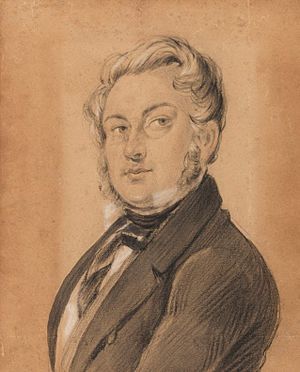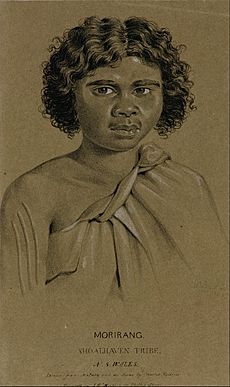Charles Rodius facts for kids
Quick facts for kids
Charles Rodius
|
|
|---|---|

Charles Rodius, self-portrait, c. 1849
|
|
| Born | 1802 |
| Died | 9 April 1860 (aged 57–58) |
Charles Rodius (born in 1802 – died 9 April 1860) was a talented artist, printmaker, and architect. He was born in Germany and trained in France. Later, he moved to England.
In 1829, he was sent to Australia as a convict. This was a punishment called penal transportation. He arrived in the penal colony of New South Wales.
Even though he is not as famous as some other convict artists, like Joseph Lycett, Charles Rodius is highly praised for his artworks. His pieces are displayed in many important Australian art galleries today.
Contents
Becoming an Artist: Early Life and Training
Charles Rodius was born in 1802 in a city called Cologne in Germany. When he was a teenager, he moved to Paris, France.
In Paris, he studied art and also worked as a teacher. He taught music, painting, drawing, and languages to important families.
A New Start in Australia
In early 1829, while living in London, England, Rodius faced a difficult situation. He was accused of taking some items from a woman's purse. He said they were gifts from his students.
However, he was found guilty. His punishment was to be sent away for seven years to the Australian penal colony of New South Wales. At the time, people described him as a "young foreigner" who dressed very fashionably.
Life and Art in Australia

Charles Rodius arrived in New South Wales in December 1829. He traveled on a ship called the Sarah, which carried convicts.
Like other artists who were convicts, such as Thomas Bock, Rodius's drawing skills were very useful. He was assigned to work for the government in Sydney.
Creating Art in the Colony
Rodius taught drawing to officers and helped design plans for new buildings. Important people in the colony, like Chief Justice Francis Forbes, also asked him to paint their portraits.
He became known as a stylish artist. Because of the support he received, he was allowed to earn his own living as an artist starting in 1832. Two years later, he received a "ticket of leave," which gave him more freedom.
Portraits and Indigenous Art
Rodius stayed in Australia and continued to create portraits of well-known people. One famous person he painted was the German explorer Ludwig Leichhardt.
According to an art expert, Rodius's portraits of Indigenous Australians truly showed his amazing skill. Some of these images might look a bit like cartoons. However, others, especially those of Aboriginal people from the Shoalhaven area, are very gentle and sensitive.
Rodius made copies of his Aboriginal artworks using a printing method called lithographs. He sold them at a price that everyone could afford. This helped many people see these interesting pictures.
In the late 1850s, Rodius became ill and suffered a stroke, which left one side of his body paralyzed. He passed away on 9 April 1860, in Liverpool Hospital in Sydney.
See also
- List of convicts transported to Australia
- Australian art

